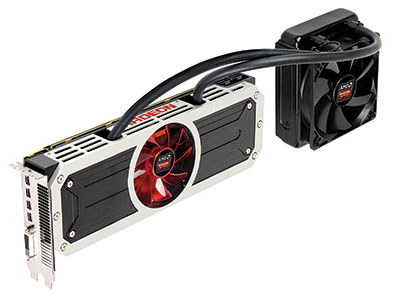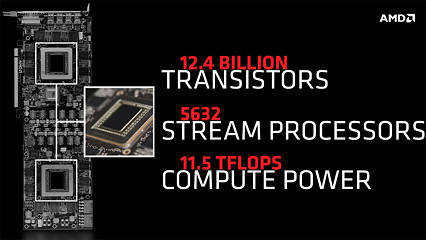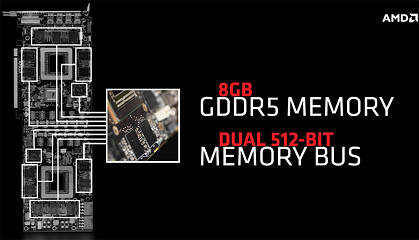 121
121
AMD Radeon R9 295X2 8 GB Review
Packaging & Contents »Introduction

Had someone told us back in October 2013 that AMD could possibly create a dual-GPU graphics card based on its fast-yet-feisty "Hawaii" silicon with all the GPU units enabled and as a two-slot card that draws its power out of just two 8-pin connectors, we'd have asked them what they were smoking and if we could have some of that stuff. Well, they now stand vindicated because the new Radeon R9 295X2 is a 30 cm-long two-slot card alright, although it also lugs along a 120 mm radiator and factory-fitted tubing that you'll have to find room in your case for (more so if you already have a liquid CPU cooler installed).
The design goals for the Radeon R9 295X2 couldn't be more clear – to offer a no-nonsense CrossFire-on-a-stick solution made up of two R9 290X chips. The idea is to pack enough graphics processing muscle into one card to make any game out there playable at 4K/60Hz, with the eye-candy cranked up. The display output configuration of four mini-DP 1.2 and a dual-link DVI should inspire multi-display gamers.
There was simply no way AMD could have done two things with this card – one, to completely air-cool the card as a dual-slot solution and, two, to power two 250W chips with just two 8-pin power connectors.
AMD overcame the first hurdle by turning to water-cooling OEM giant Asetek for an innovative cooling solution, a factory-fitted, closed-loop cooler with two block + pump assemblies serially plumbed to a single 120 mm radiator + reservoir assembly. The radiator may look inadequate at first, but our temperature measurements show that AMD managed to make it work without overheating. The card still has a 100 mm red LED-lit fan, which cools the centrally located VRM heatsink and the base-plate that cools the memory and bridge chip.
The second hurdle was overcome, of course, by breaching ATX specifications and drawing more power than allowed from the two 8-pin power connectors. For the Radeon R9 295X2, AMD recommends that the plugs powering the card are wired to a +12V rail on your PSU with at least 28A of current on tap per plug. Looking at these power requirements, we are forced to at least recommend a 750W PSU for a build with one of these cards, preferably one with a single +12V rail design and a decent efficiency rating.
Under the hood, the Radeon R9 295X2 is every bit a duo of two R9 290X GPUs. Each of the two 6.2 billion-transistor GPUs has all its 2,816 GCN2 stream processors enabled, along with 176 texture memory units, 64 ROPs, and 512-bit wide GDDR5 memory interfaces that each hold 4 GB of memory for a total of 8 GB on the card, which should be more than enough memory for any display configuration you can try out with this card.

At US $1,499, the Radeon R9 295X2 is about $400 more expensive than two R9 290X cards, which looks steep, but is nowhere as obnoxious as the $3000 NVIDIA will ask for its GeForce GTX TITAN-Z since that is $1000 costlier than buying a pair of GTX TITAN-Black cards. In a way, NVIDIA’s marketing arrogance is working in AMD's favor. Despite being a $1500 card, which is 50% costlier than its predecessor, the HD 7990, and a stunning 115% costlier than the HD 6990, it ends up looking like a good option on paper. That said, our review will show how well the R9 295X2 holds up in practice.
| GeForce GTX 780 | Radeon R9 290 | Radeon R9 290X | Radeon HD 7990 | GeForce GTX Titan | GeForce GTX 780 Ti | GeForce GTX 690 | Radeon R9 295X2 | |
|---|---|---|---|---|---|---|---|---|
| Shader Units | 2304 | 2560 | 2816 | 2x 2048 | 2688 | 2880 | 2x 1536 | 2x 2816 |
| ROPs | 48 | 64 | 64 | 2x 32 | 48 | 48 | 2x 32 | 2x 64 |
| Graphics Processor | GK110 | Hawaii | Hawaii | 2x Tahiti | GK110 | GK110 | 2x GK104 | 2x Hawaii |
| Transistors | 7100M | 6200M | 6200M | 2x 4310M | 7100M | 7100M | 2x 3500M | 2x 6200M |
| Memory Size | 3072 MB | 4096 MB | 4096 MB | 2x 3072 MB | 6144 MB | 3072 MB | 2x 2048 MB | 2x 4096 MB |
| Memory Bus Width | 384 bit | 512 bit | 512 bit | 2x 384 bit | 384 bit | 384 bit | 2x 256 bit | 2x 512 bit |
| Core Clock | 863 MHz+ | 947 MHz | 1000 MHz | 1000 MHz | 837 MHz+ | 876 MHz+ | 915 MHz+ | 1018 MHz |
| Memory Clock | 1502 MHz | 1250 MHz | 1250 MHz | 1500 MHz | 1502 MHz | 1750 MHz | 1502 MHz | 1250 MHz |
| Price | $480 | $460 | $570 | $900 | $1000 | $660 | $1000 | $1500 |
Mar 28th, 2025 11:04 EDT
change timezone
Latest GPU Drivers
New Forum Posts
- 8 cores cpu (20)
- How to quickly & easily fix coil-whine(coil choke noise) (1144)
- Microcenter GPU Stock status (60)
- revisiting hpet bcdedit tweaks: what are your timer bench results and settings? (113)
- RTX 3050 with GA107 GPU incomplete information and sensor issue. (1)
- Upgrade from a AMD AM3+ to AM4 or AM5 chipset MB running W10? (8)
- TPU's Nostalgic Hardware Club (20136)
- What's your latest tech purchase? (23418)
- RX580 BIOS PROBLEM (5)
- Compatibility With Alphacool Core RX 9070 XT Taichi GPU WaterBlock ?? (1)
Popular Reviews
- Sapphire Radeon RX 9070 XT Pulse Review
- Samsung 9100 Pro 2 TB Review - The Best Gen 5 SSD
- Assassin's Creed Shadows Performance Benchmark Review - 30 GPUs Compared
- Pulsar Feinmann F01 Review
- ASRock Phantom Gaming B860I Lightning Wi-Fi Review
- be quiet! Pure Rock Pro 3 Black Review
- Sapphire Radeon RX 9070 XT Nitro+ Review - Beating NVIDIA
- ASRock Radeon RX 9070 XT Taichi OC Review - Excellent Cooling
- AMD Ryzen 7 9800X3D Review - The Best Gaming Processor
- AMD Ryzen 9 9950X3D Review - Great for Gaming and Productivity
Controversial News Posts
- MSI Doesn't Plan Radeon RX 9000 Series GPUs, Skips AMD RDNA 4 Generation Entirely (142)
- Microsoft Introduces Copilot for Gaming (123)
- AMD Radeon RX 9070 XT Reportedly Outperforms RTX 5080 Through Undervolting (118)
- NVIDIA Reportedly Prepares GeForce RTX 5060 and RTX 5060 Ti Unveil Tomorrow (115)
- Over 200,000 Sold Radeon RX 9070 and RX 9070 XT GPUs? AMD Says No Number was Given (100)
- NVIDIA GeForce RTX 5050, RTX 5060, and RTX 5060 Ti Specifications Leak (96)
- Retailers Anticipate Increased Radeon RX 9070 Series Prices, After Initial Shipments of "MSRP" Models (90)
- China Develops Domestic EUV Tool, ASML Monopoly in Trouble (88)





